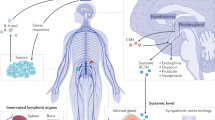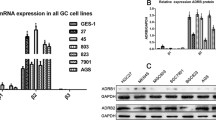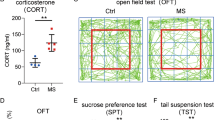Abstract
Stress can alter immunological, neurochemical and endocrinological functions, but its role in cancer progression is not well understood. Here, we show that chronic behavioral stress results in higher levels of tissue catecholamines, greater tumor burden and more invasive growth of ovarian carcinoma cells in an orthotopic mouse model. These effects are mediated primarily through activation of the tumor cell cyclic AMP (cAMP)–protein kinase A (PKA) signaling pathway by the β2 adrenergic receptor (encoded by ADRB2). Tumors in stressed animals showed markedly increased vascularization and enhanced expression of VEGF, MMP2 and MMP9, and we found that angiogenic processes mediated the effects of stress on tumor growth in vivo. These data identify β-adrenergic activation of the cAMP–PKA signaling pathway as a major mechanism by which behavioral stress can enhance tumor angiogenesis in vivo and thereby promote malignant cell growth. These data also suggest that blocking ADRB-mediated angiogenesis could have therapeutic implications for the management of ovarian cancer.
This is a preview of subscription content, access via your institution
Access options
Subscribe to this journal
Receive 12 print issues and online access
$209.00 per year
only $17.42 per issue
Buy this article
- Purchase on Springer Link
- Instant access to full article PDF
Prices may be subject to local taxes which are calculated during checkout




Similar content being viewed by others
Change history
19 November 2021
A Correction to this paper has been published: https://doi.org/10.1038/s41591-021-01566-5
References
Antoni, M.H. et al. The influence of bio-behavioural factors on tumour biology: pathways and mechanisms. Nat. Rev. Cancer 6, 240–248 (2006).
Justice, A. Review of the effects of stress on cancer in laboratory animals: importance of time of stress application and type of tumor. Psychol. Bull. 98, 108–138 (1985).
Ben-Eliyahu, S. The promotion of tumor metastasis by surgery and stress: immunological basis and implications for psychoneuroimmunology. Brain Behav. Immun. 17 (Suppl.), S27–S36 (2003).
Reiche, E.M., Nunes, S.O. & Morimoto, H.K. Stress, depression, the immune system, and cancer. Lancet Oncol. 5, 617–625 (2004).
McEwen, B. Seminars in Medicine of the Beth Israel Deaconness Medical Center: protective and damaging effects of stress mediators. N. Engl. J. Med. 338, 171–179 (1998).
Lutgendorf, S.K. et al. Vascular endothelial growth factor and social support in patients with ovarian carcinoma. Cancer 95, 808–815 (2002).
Lutgendorf, S.K. et al. Stress-related mediators stimulate vascular endothelial growth factor secretion by two ovarian cancer cell lines. Clin. Cancer Res. 9, 4514–4521 (2003).
Thaker, P.H. et al. Antivascular therapy for orthotopic human ovarian carcinoma through blockade of the vascular endothelial growth factor and epidermal growth factor receptors. Clin. Cancer Res. 11, 4923–4933 (2005).
Paredes, A. et al. Stress promotes development of ovarian cysts in rats: the possible role of sympathetic nerve activation. Endocrine 8, 309–315 (1998).
Landen, C.N. et al. Therapeutic EphA2 gene targeting in vivo using neutral liposomal small interfering RNA delivery. Cancer Res. 65, 6910–6918 (2005).
Langley, R.R. et al. Tissue-specific microvascular endothelial cell lines from H-2K(b)-tsA58 mice for studies of angiogenesis and metastasis. Cancer Res. 63, 2971–2976 (2003).
Glaser, R. & Kiecolt-Glaser, J.K. Stress-induced immune dysfunction: implications for health. Nat. Rev. Immunol. 5, 243–251 (2005).
Lutgendorf, S. et al. Social support, psychological distress and natural killer cell activity in ovarian cancer. J. Clin. Oncol. 23, 7105–7113 (2005).
Chrousos, G.P. & Gold, P.W. The concepts of stress and stress system disorders. Overview of physical and behavioral homeostasis. J. Am. Med. Assoc. 267, 1244–1252 (1992).
Basu, S. et al. The neurotransmitter dopamine inhibits angiogenesis induced by vascular permeability factor/vascular endothelial growth factor. Nat. Med. 7, 569–574 (2001).
Teunis, M.A. et al. Reduced tumor growth, experimental metastasis formation, and angiogenesis in rats with a hyperreactive dopaminergic system. FASEB J. 16, 1465–1467 (2002).
Seeman, T.E., Berkman, L.F., Blazer, D. & Rowe, J.W. Social ties and support and neuroendocrine function: the McArthur studies of successful aging. Ann. Behav. Med. 16, 95–106 (1994).
Turner-Cobb, J.M., Sephton, S.E., Koopman, C., Blake-Mortimer, J. & Spiegel, D. Social support and salivary cortisol in women with metastatic breast cancer. Psychosom. Med. 62, 337–345 (2000).
Antoni, M.H. et al. Cognitive-behavioral stress management reduces distress and 24-hour urinary free cortisol output among symptomatic HIV-infected gay men. Ann. Behav. Med. 22, 29–37 (2000).
Costanzo, E.S. et al. Psychosocial factors and interleukin-6 among women with advanced ovarian cancer. Cancer 104, 305–313 (2005).
Sheridan, J.F. et al. Restraint stress differentially affects anti-viral cellular and humoral immune responses in mice. J. Neuroimmunol. 31, 245–255 (1991).
Aarons, R.D. & Molinoff, P.B. Changes in the density of beta adrenergic receptors in rat lymphocytes, heart and lung after chronic treatment with propranolol. J. Pharmacol. Exp. Ther. 221, 439–443 (1982).
Exton, M.S. et al. Behaviorally conditioned immunosuppression in the rat is regulated via noradrenaline and beta-adrenoceptors. J. Neuroimmunol. 131, 21–30 (2002).
Halder, J. et al. Focal adhesion kinase targeting for therapy of ovarian carcinoma using in vivo siRNA delivery in neutral liposomes. Clin. Cancer Res. (in the press).
Xu, L. et al. Inhibition of malignant ascites and growth of human ovarian carcinoma by oral administration of a potent inhibitor of the vascular endothelial growth factor receptor tyrosine kinases. Int. J. Oncol. 16, 445–454 (2000).
Reinmuth, N. et al. Induction of VEGF in perivascular cells defines a potential paracrine mechanism for endothelial cell survival. FASEB J. 15, 1239–1241 (2001).
Passaniti, A. et al. A simple, quantitative method for assessing angiogenesis and antiangiogenic agents using reconstituted basement membrane, heparin, and fibroblast growth factor. Lab. Invest. 67, 519–528 (1992).
Radinsky, R. et al. A rapid colorimetric in situ messenger RNA hybridization technique for analysis of epidermal growth factor receptor in paraffin-embedded surgical specimens of human colon carcinomas. Cancer Res. 53, 937–943 (1993).
Hu, L. et al. Vascular endothelial growth factor trap combined with paclitaxel strikingly inhibits tumor and ascites, prolonging survival in a human ovarian cancer model. Clin. Cancer Res. 11, 6966–6971 (2005).
Daldrup, H. et al. Correlation of dynamic contrast-enhanced MR imaging with histologic tumor grade: comparison of macromolecular and small-molecular contrast media. AJR Am. J. Roentgenol. 171, 941–949 (1998).
Acknowledgements
The authors thank I.J. Fidler, J. Price, C. Bucana, G. Gallick and A. Johnson for their helpful input and discussions regarding this work. We thank D. Reynolds for assistance with immunohistochemistry. We also thank J. Johnson and E. Schrock for assistance with manuscript preparation. This work was supported by US National Institutes of Health (NIH) grants (CA-11079301 and CA-10929801), the Donna Marie Cimitile-Fotheringham Award for Ovarian Cancer Research, the U.T. M.D. Anderson Ovarian Cancer SPORE (2P50 CA083639-06A1), and a Program Project Development Grant from the Ovarian Cancer Research Fund, Inc. to A.K.S., NIH grant CA-104825 to S.K.L., and NIH grant A152737 to S.W.C.
Author information
Authors and Affiliations
Contributions
P.H.T., L.Y.H. and A.A.K. designed and performed experiments and wrote portions of the manuscript. J.M.A. and R.T. designed and performed VEGF transcription and promoter assays and edited the manuscript. C.L., N.B.J., G.A.-P., W.M.M., Y.G.L., M.L., L.S.M., T.J.K., C.N.L. and Y.L. designed and performed experiments and edited the manuscript. E.F. and R.A.N. designed and performed catecholamine analyses and edited the manuscript. J.A.B., M.R. and V.K. designed and performed the imaging experiments and edited the manuscript. A.M.S. and G.L.-B. performed siRNA incorporations and edited the manuscript. R.L.C. and D.M.G. performed statistical analyses and edited the manuscript. S.K.L., S.W.C. and A.K.S. designed the overall study, analyzed data and edited the manuscript.
Corresponding author
Ethics declarations
Competing interests
The authors declare no competing financial interests.
Supplementary information
Supplementary Fig. 1
Characterization of chronic stress in a mouse model. (PDF 217 kb)
Supplementary Fig. 2
Effect of chronic stress on in vivo ovarian cancer growth. (PDF 93 kb)
Supplementary Fig. 3
Effet of chronic stress and social isolation on angiogenesis. (PDF 146 kb)
Supplementary Fig. 4
Chronic stress does not promote angiogenesis in the β-adrenoreceptor null tumors. (PDF 114 kb)
Supplementary Fig. 5
Angiogenic cytokine expression in tumors from stressed mice. (PDF 172 kb)
Supplementary Fig. 6
Effect of stress hormones and various antagonists on endothelial cell migration and proliferation. (PDF 129 kb)
Supplementary Fig. 7
Effect of VEGF inhibitors on mouse body weight. (PDF 93 kb)
Supplementary Fig. 8
Chronic stress effects on mouse cardiac physiology, lymphangiogenesis and tumor cell proliferation. (PDF 149 kb)
Rights and permissions
About this article
Cite this article
Thaker, P., Han, L., Kamat, A. et al. Chronic stress promotes tumor growth and angiogenesis in a mouse model of ovarian carcinoma. Nat Med 12, 939–944 (2006). https://doi.org/10.1038/nm1447
Received:
Accepted:
Published:
Issue Date:
DOI: https://doi.org/10.1038/nm1447
This article is cited by
-
Neuromorphic electro-stimulation based on atomically thin semiconductor for damage-free inflammation inhibition
Nature Communications (2024)
-
The cancer-immune dialogue in the context of stress
Nature Reviews Immunology (2024)
-
Stress-induced stenotic vascular remodeling via reduction of plasma omega-3 fatty acid metabolite 4-oxoDHA by noradrenaline
Scientific Reports (2024)
-
Estrogen-receptor status determines differential regulation of α1- and α2-adrenoceptor-mediated cell survival, angiogenesis, and intracellular signaling responses in breast cancer cell lines
Medical Oncology (2024)
-
Chronic stress in solid tumor development: from mechanisms to interventions
Journal of Biomedical Science (2023)



